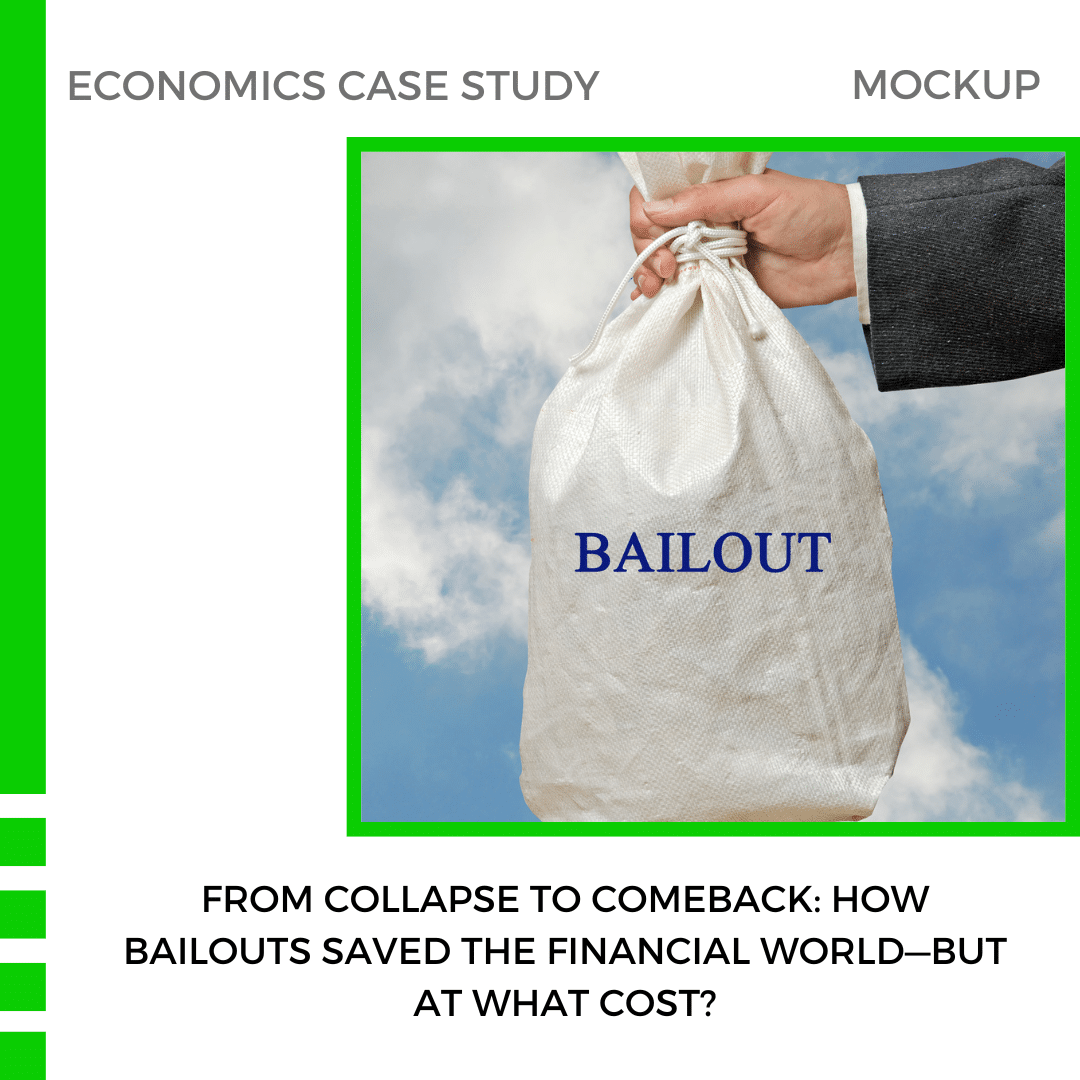
From Collapse to Comeback: How Bailouts Saved the Financial World—But at What Cost?
Introduction
This case study explores the complex dynamics surrounding bailouts, focusing on government intervention in the financial sector after the 2008 global economic crisis. The narrative examines the rationale behind these actions, the criticisms they triggered, and their long-term impact on economic recovery and public trust. Students will assess key stakeholders, evaluate the ethical dilemmas of bailouts, and propose solutions to manage future financial crises without fostering excessive risk-taking. The goal is to promote critical thinking about systemic risk, government policy, and the delicate balance between rescuing failing institutions and ensuring market discipline.
Background of the Financial Crisis
Overview of the 2008 Financial Crisis
The 2008 financial crisis—often referred to as the Great Recession—began with the collapse of the U.S. housing market. As defaults on subprime mortgages surged, financial institutions faced mounting losses, triggering a global financial panic. Major banks, hedge funds, and corporations worldwide experienced liquidity shortages while stock markets plummeted, leading to an economic downturn.
Causes of the Crisis
Several factors contributed to the crisis:
- Subprime mortgage lending and excessive credit growth
- Securitization of risky financial assets without adequate oversight
- Lax regulations and failure to anticipate market vulnerabilities
- Excessive risk-taking by financial institutions due to short-term profit motives
The interconnected global financial system amplified the impact, requiring immediate government intervention to avoid total economic collapse.
Government Intervention:
Rationale for Bailouts
The decision to implement bailouts was primarily driven by the need to restore confidence in the financial system and prevent a domino effect of bankruptcies. Bailouts aimed to:
- Stabilize systemically important financial institutions.
- Protect consumer savings and investments.
- Ensure economic stability by preventing job losses and business closures.
Implementation of Bailouts
Governments provided financial relief through various channels, such as:
- Capital injections into distressed institutions.
- Asset purchases of toxic financial products.
- Loan guarantees to restore liquidity.
Each bailout package was tailored to meet the unique needs of affected banks and institutions, with the goal of preventing panic and restoring investor confidence.
Case Study:
Background of MegaBank
MegaBank was a leading financial institution that heavily invested in subprime mortgage-backed securities. As the crisis unfolded, the bank faced insolvency, posing a severe threat to the global financial system. MegaBank’s failure would have triggered a ripple effect, potentially causing the collapse of smaller banks and businesses dependent on the credit system.
Government’s Bailout Decision
In response, the government provided MegaBank with a multi-billion-dollar bailout that included capital support and asset guarantees. Although this move prevented MegaBank’s collapse, it sparked controversy because taxpayer funds were used to rescue a private institution.
Controversy Surrounding Bailouts
Criticism and Public Sentiment
- Taxpayer Backlash: Citizens criticized the government for spending public funds to rescue banks, arguing that the financial sector should bear the consequences of its mismanagement.
- Moral Hazard: The bailout created concerns about moral hazard, as it encouraged risky behaviour among financial institutions, knowing they would be rescued in a crisis.
- Social Inequality: Bailouts disproportionately benefited wealthy investors and corporate leaders, while ordinary citizens suffered through foreclosures, job losses, and austerity measures.
Long-Term Implications of Bailouts
Economic Recovery
While bailouts helped stabilize the financial sector, the debate over their effectiveness persists. Critics argue that they delayed much-needed reforms, while supporters highlight how they prevented a full-blown depression.
Regulatory Reforms
Governments introduced new regulations to prevent future crises, including stricter capital requirements and the creation of frameworks for resolving failing banks without public funds. These reforms aimed to strike a balance between stability and accountability.
Public Trust
Public perception of government intervention was deeply affected. Trust in financial institutions and policymakers declined, prompting efforts to rebuild confidence through transparency and accountability initiatives.
Tasks for Students
- Stakeholder Analysis: Evaluate the interests and concerns of stakeholders such as government officials, taxpayers, and shareholders involved in MegaBank’s bailout.
- Policy Critique: Assess the arguments for and against bailouts, considering alternatives to mitigate systemic risks.
- Economic Impact Study: Analyze the long-term effects of bailouts on financial stability and economic growth using empirical data.
- Policy Recommendations: Propose actionable strategies to prevent future crises, including responsible lending practices and regulatory oversight.
- Public Trust Campaign: Develop a communication plan to rebuild public trust in financial institutions post-bailout.
Possible Solution:
A public-private partnership model, which is the need for bailouts with accountability, is the public-private partnership (PPP) model. Under this approach, governments provide conditional financial support to distressed institutions in exchange for:
- Equity stakes: Governments gain partial ownership, sharing both profits and risks.
- Performance-based incentives: Financial support is tied to achieving specific benchmarks, such as lending targets or job creation.
- Accountability measures: Public funds are subject to independent audits to ensure transparency.
This model mitigates moral hazard by aligning public and private interests while ensuring taxpayers benefit from bailed-out institutions’ recovery. The World Bank’s official website provides more about public-private partnerships.
Conclusion
The case of bailouts in the aftermath of the 2008 financial crisis underscores the delicate balance between rescuing failing institutions and maintaining market discipline. While bailouts stabilized the financial sector, they raised questions about fairness, accountability, and long-term consequences. Moving forward, policymakers must adopt innovative approaches—such as the Public-Private Partnership Model—to address future crises without compromising public trust or encouraging reckless behaviour. By critically analyzing this case study, students gain insights into the complexities of managing systemic risk and the importance of transparent policy decisions.
Explore Business Models of Global Companies and Indian Companies
Tag:2008 financial crisis, bailout, bank bailout controversy, banking regulations, case studies, case study, economic recovery, economics case study, financial market dynamics, government intervention, mockup case study, moral hazard, public trust, public-private partnership, Systemic Risk, taxpayer funds



